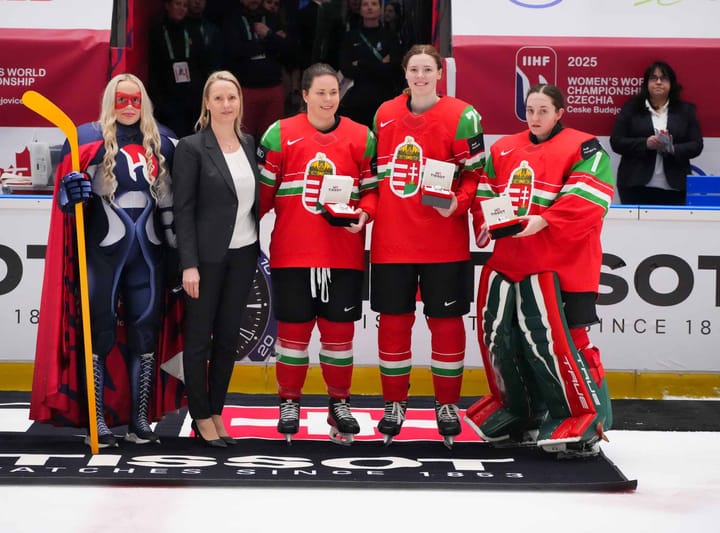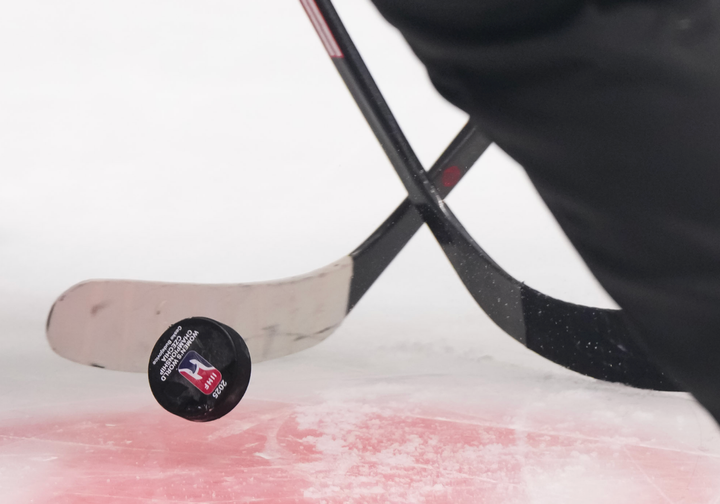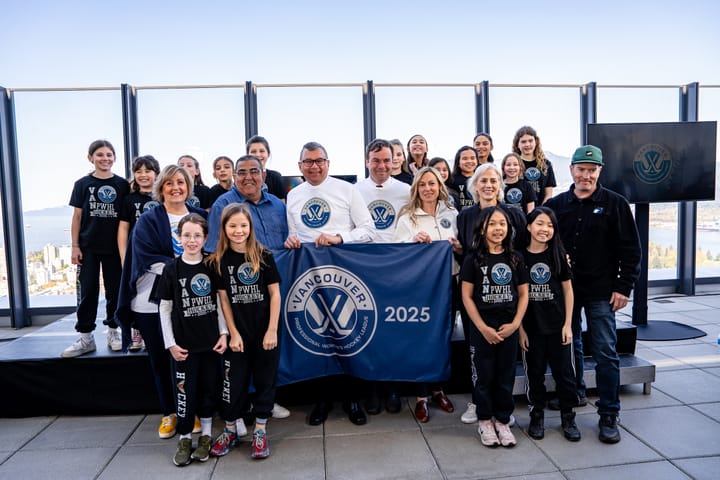How NCAA women’s hockey players are creating their own content
Why efforts like those from Cornell’s Finley Frechette and Syracuse’s Lindsay Eastwood are important in the greater women’s hockey media landscape
Cornell junior forward Finley Frechette still remembers the best thing about going through the recruiting process.
“My favorite part was being in the locker room with the girls, and staying overnight with them or going to dinner with them and really understanding what it’s like to be on the team and to be a student athlete here,” she said. “The fact that I am one of those now, I think it gives me a really unique perspective on what it’s like to be at the school and to go here.”
Frechette hopes to bring that exact insider perspective to a wider audience with a new media venture. Along with fellow student Chris Morales, Frechette created the “Over the Goal Line” podcast, which gives an inside look into Cornell’s women’s hockey program.
A communications student in Cornell’s College of Agriculture and Life Sciences, Frechette has been eyeing a career in broadcast media for some time. Hosting her own podcast at Cornell was always a goal, but the idea wasn’t set into motion until Morales came in. He approached her coach, Doug Derraugh, and asked if he knew of any players who would want to host a podcast about the team.
Knowing Frechette’s career aspirations, Derraugh connected her with Morales to get started.
“It was [Morales’] goal before he graduated to be a producer for a podcast, and it was sort of my goal before I graduated to have my own podcast, so it really worked out that we were both really into it and passionate and wanted to give this thing a go,” Frechette said.
They first started talking early on in the season and made plans to launch for the second semester.
“We were planning it out, planning how we were going to do everything: logistics, what platform that it was going to be on, what we wanted our name to be, what we wanted our logo to look like,” Frechette said. “And then I started recording things over Christmas break, and that’s when we put things into motion.”
Five episodes in, the Over the Goal Line podcast is already proving to be a valuable and fun resource for all listeners to get to know the Cornell women’s hockey team. So far episodes have featured her younger sister, Gillis, captain Micah Zandee-Hart, top goaltender Lindsay Browning, freshman Izzy Daniel, and longtime teammates Jaime Bourbonnais and Amy Curlew. They’ve discussed the team’s involvement with Do It For Daron, the regular season stretch run, and the contributions of Cornell’s senior class, to name a few topics.
Frechette says she was partly inspired by Cornell’s fans, and wanting to give them a little bit more access into what goes on with the team outside of games.
“They’re really passionate. They ask us to sign autographs and I honestly never thought I would sign an autograph in my entire life,” she said. “So it was just the fact that I could do something for them so that they can see what it’s like when we’re on the bus, or the little things that you don’t necessarily see from the media or because you’re not actually in the locker room.”
At Syracuse University, senior captain Lindsay Eastwood has been doing similar work herself to give fans and followers deeper access to the Orange’s women’s hockey team. Eastwood, a fifth-year player, is pursuing a master’s degree in Television, Radio and Film within Syracuse’s Newhouse School of Public Communications. She hosts her own video series about the team, called “Keeping Up With Cuse Ice”, which was actually started two years ago by former goaltender Abbey Miller.
This season, she’s worked with classmate Allie Olnowich to develop more videos for the program.
“It’s kind of the same idea; we want people to be familiar with the girls without their helmets on,” Eastwood said. “It’s all fun and light-hearted stuff. We first started out with ‘Rookie on the Record’, so we interviewed all the rookies, and I’d ask them a bunch of fun, get-to-know-you questions and Allie would then do all the post production-stuff. She’d edit, come up with music and title screens and all that.”
Eastwood also mentioned recruiting as one focus for her videos. Showing a team’s personality and daily happenings can help prospective players get a better understanding of what it would be like to be a part of the team. But this insight into player personalities and banter is valuable to all Syracuse fans.
“I think it just shows you the personalities people have and the fun you can bring out of them and how much fun we have here,” Eastwood said. “You could get someone else to come in and do it and they’d probably be a little bit more serious, but when it’s a player doing it, you can have a lot of fun with it and goof around and make it a little more laid-back. And probably get a little more personality out of the players.”
Player-produced content isn’t a replacement for dedicated media coverage from outside entities, like local or mainstream outlets, but it does provide another channel for fans and viewers to connect with women’s hockey. Especially when you consider that their goals are, at least partly, to give deeper insight into themselves and their teammates as hockey players, there’s tangible value to that content in today’s media landscape, specifically as it pertains to women’s sports.
As is oft-referenced, only about 4% of sports media coverage is dedicated to women’s sports. That leaves literally countless stories of women’s athletes that go untold. And, as we also often see, the coverage that we do get doesn’t necessarily center those stories around the athletes themselves, in the context of their sports and their accomplishments in competition. In women’s hockey, for example, mainstream stories often discuss the precarious state of professional hockey, players’ relatives who play men’s hockey, and everyone’s favorite topic: growing the game.
This doesn’t go unnoticed by the most important people involved in women’s hockey. Canadian Olympic forward and former Cornell All-American Brianne Jenner hasn’t been shy in the past about highlighting the types of questions she gets asked as a professional women’s hockey player.
“She questioned whether, for example, NHL superstar Sidney Crosby would be asked by reporters if he feels lucky to have such a nice dressing room after every practice.” — “Olympic athlete rips news media for coverage”, Doug Collie, Mountain View Today
Dr. Donna Gall recently concluded a doctoral dissertation titled “Frozen Out: Audiences, Affect and Women’s Hockey”. Her study focused less on media coverage and more on what the potential audience for the sport looks like in Canada, and what drives them to watch. She was inspired to pursue this line of research after directing a documentary in 2015 called Play Fair, which questioned the presumption that women have already attained fair and equal rights in sports.
The film featured Canadian national team players such as Hayley Wickenheiser and Charline Labonté, who also played in the Canadian Women’s Hockey League (CWHL). When she was working on that project, Dr. Gall was haunted by the tone of those players when they told her, “Millions of people watch us play hockey during the Olympics, but then they don’t watch us afterwards.”
That was what sparked Dr. Gall’s research in her dissertation. For the study, she conducted a survey about people’s interest in women’s hockey and received over 1,000 responses, which she says shows a clear audience for women’s hockey. She also conducted a series of six focus groups with 25 people. She asked questions like, “Do you think people should watch women play hockey?”, which collectively received a resounding “yes” in response.
She also asked questions like, “Have you ever watched a professional women’s hockey game?” and the responses here were much more mixed.
“Just over half indicated that they had, and most had been kind of a series of happenstance,” Dr. Gall said. “There were very few who are habitual viewers of the game. And so then the key question became, well, why?”
Most people said that they didn’t know when and where they could watch professional women’s hockey. In the focus groups, Dr. Gall explored that further. There seemed to be a disconnect between the CWHL’s promotional efforts reaching potential women’s hockey fans with this info. But participants also told her they found it tricky to stay in the loop, because the press coverage of women’s hockey was nearly always dedicated to the sport’s problems, not necessarily about the actual hockey.
“They [the media] just didn’t talk about the game. They didn’t talk about the play,” she said. “Instead it became this sort of meta-narrative around the problems, which sort of affirmed the idea that [women’s hockey] is marginalized and less valuable.”
In her dissertation, Dr. Gall argued strongly that women’s hockey audiences are being perpetually underserved by broadcasters who won’t air games because they don’t believe there’s enough interest. She finds this to be a rather flawed circular argument.
“It’s the chicken and egg. Does the audience come first, and the broadcaster responds, or does the broadcaster build the audience?” Dr. Gall asked. “And so I argued in my dissertation that, with the sort of level of interest I was getting from my dinky little doctoral dissertation, and the response I was getting from people who were really interested, my argument was like, ‘Here’s an audience. You’re waiting for an audience; here’s one right now.’ And to me, I kind of call it ‘I killed the chicken.’”
Dr. Gall also spoke about the idea of “hockey mythology”, where a marquee or historic moment, such as the 1972 Summit Series in men’s hockey, builds a strong emotional connection for fans. That mythology then fosters a long-term relationship with the sport, and there’s no shortage of those moments in men’s hockey. But it’s a bit lacking in women’s hockey, partially because of the way we talk about the sport, and partially because those moments aren’t in the spotlight.
“The women’s game is kind of denied that emotional connection, because the stories aren’t told and they’re not known,” Dr. Gall said.
Content like Frechette’s podcast and Eastwood’s videos are, on their own, not going to supplant the existing coverage about women’s hockey and reconstruct decades-old narratives. But it’s helpful to have players driving some content, because it keeps their roles as hockey players front and center – while still building a deeper connection with fans.
“I’m actually talking to the players, I’m asking them about their families, and asking them about how they chose Cornell or their favorite play in the game – things that you wouldn’t necessarily get from a brief video or picture,” Frechette said of the value her podcast offers. “It’s trying to get to the bottom of [things like] why someone is so focused on the ice when someone else’s more out in the clouds just playing hockey.”
While the responsibility for creating engaging content to build emotional connections does not fall squarely on the shoulders of the players, Dr. Gall thinks that those efforts can help build stronger relationships with fans, as long as they’re thinking about their potential audience.
“For some of the player-created content, player-driven content, to me, it’s just like everything else. It’s about distribution and discoverability, and how do you find the audience for that material?” Dr. Gall said.
“I would say it’s almost everybody’s responsibility, the players as well, to kind of be messengers of the game, and to let their passion for the game come through if they can, and if they’re comfortable. It really isn’t their responsibility – I honestly think it’s the responsibility of the broadcasters – but you can help by talking it up. Or, if you’re moved to make creative content around it, then trying to think about who your audience might be is a key component of that.”
Outside of her podcast, Frechette has undertaken a number of other media ventures. Last summer, she interned for CNN in New York City, where she worked to cover breaking news. She also had a radio show in the fall with a couple of friends from Cornell’s men’s lacrosse team. From her work on Over the Goal Line, she’s already learned a lot about finding her own voice in media.
“I think I’m already getting more confident and sort of being more myself. The first few episodes I had a full script written out and I would read word for word, and now I’ve started to have bullet points, but also let myself just talk and just speak,” Frechette said. “[In one episode], I was talking about our Harvard-Dartmouth series when we beat Harvard 7-0 and I really, aggressively said, ‘Woohoo, that was fun.’ After, I was like, ‘Did that sound weird? Was that a strange thing to say?’ And then I was like, ‘You know what, no, I’m going to keep it. I want to be authentically myself. I want my voice heard.’”
Frechette cites The New York Times’ “The Daily” podcast as a source of inspiration for her work, particularly when it comes to striking an easygoing, conversational tone. For Eastwood, her biggest inspiration is Casse Campbell, former Canadian Olympic gold medal winner and current “Hockey Night in Canada” host.
Eastwood’s experience in media and communications also extends beyond her team. She served as a communications intern with CARHA Hockey, a non-profit in Canada that provides resources and benefits to the adult recreational and oldtimers hockey community. She’s also an intern with Syracuse University Athletics. She recently shadowed a friend on a studio show during a Syracuse Crunch (AHL) game and did color commentary for a club hockey game a few weeks ago.
Since starting her video series, Eastwood feels like she’s grown a lot. She’s picked up a lot of editing skills, and thinks her delivery has come a long way.
“I’m a rookie at this, too,” she joked. “I think that they’re getting better and better as we go. If I look back at my videos I did last year, I’m like, ‘Oh my gosh, I’m reading off my phone.’ So I think it’s been awesome practice for me and I think I can see a little bit of growth. I’m just trying to be more comfortable in front of the camera as well, since that’s what I want to do one day.”
For her podcast, Frechette has been really happy so far with the reception. She mentioned how, while having a conversation with her dad in the stands, another man overheard them talking. He went up to her dad afterward and asked if he was Finley Frechette’s father, because he recognized her voice from the show.
“I think that I am sort of trying to break barriers a little bit, in the fact that I am an athlete on the team and I also have a podcast about the team,” Frechette said. “I think that that’s pretty cool. And I’m really proud of myself that I was able to kind of do this and put it out on major platforms for people to listen to.”





Comments ()